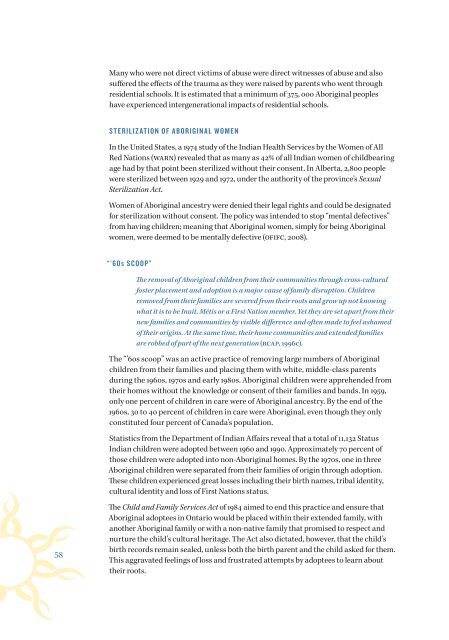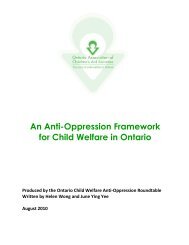English - Ontario Association of Children's Aid Societies
English - Ontario Association of Children's Aid Societies
English - Ontario Association of Children's Aid Societies
Create successful ePaper yourself
Turn your PDF publications into a flip-book with our unique Google optimized e-Paper software.
Many who were not direct victims <strong>of</strong> abuse were direct witnesses <strong>of</strong> abuse and also<br />
suffered the effects <strong>of</strong> the trauma as they were raised by parents who went through<br />
residential schools. It is estimated that a minimum <strong>of</strong> 375, 000 Aboriginal peoples<br />
have experienced intergenerational impacts <strong>of</strong> residential schools.<br />
STERILIZATION OF ABORIGINAL WOMEN<br />
In the United States, a 1974 study <strong>of</strong> the Indian Health Services by the Women <strong>of</strong> All<br />
Red Nations (WARN) revealed that as many as 42% <strong>of</strong> all Indian women <strong>of</strong> childbearing<br />
age had by that point been sterilized without their consent. In Alberta, 2,800 people<br />
were sterilized between 1929 and 1972, under the authority <strong>of</strong> the province’s Sexual<br />
Sterilization Act.<br />
Women <strong>of</strong> Aboriginal ancestry were denied their legal rights and could be designated<br />
for sterilization without consent. The policy was intended to stop “mental defectives”<br />
from having children; meaning that Aboriginal women, simply for being Aboriginal<br />
women, were deemed to be mentally defective (OFIFC, 2008).<br />
“’60s SCOOP”<br />
The removal <strong>of</strong> Aboriginal children from their communities through cross-cultural<br />
foster placement and adoption is a major cause <strong>of</strong> family disruption. Children<br />
removed from their families are severed from their roots and grow up not knowing<br />
what it is to be Inuit, Métis or a First Nation member. Yet they are set apart from their<br />
new families and communities by visible difference and <strong>of</strong>ten made to feel ashamed<br />
<strong>of</strong> their origins. At the same time, their home communities and extended families<br />
are robbed <strong>of</strong> part <strong>of</strong> the next generation (RCAP, 1996c).<br />
The “’60s scoop” was an active practice <strong>of</strong> removing large numbers <strong>of</strong> Aboriginal<br />
children from their families and placing them with white, middle-class parents<br />
during the 1960s, 1970s and early 1980s. Aboriginal children were apprehended from<br />
their homes without the knowledge or consent <strong>of</strong> their families and bands. In 1959,<br />
only one percent <strong>of</strong> children in care were <strong>of</strong> Aboriginal ancestry. By the end <strong>of</strong> the<br />
1960s, 30 to 40 percent <strong>of</strong> children in care were Aboriginal, even though they only<br />
constituted four percent <strong>of</strong> Canada’s population.<br />
Statistics from the Department <strong>of</strong> Indian Affairs reveal that a total <strong>of</strong> 11,132 Status<br />
Indian children were adopted between 1960 and 1990. Approximately 70 percent <strong>of</strong><br />
those children were adopted into non-Aboriginal homes. By the 1970s, one in three<br />
Aboriginal children were separated from their families <strong>of</strong> origin through adoption.<br />
These children experienced great losses including their birth names, tribal identity,<br />
cultural identity and loss <strong>of</strong> First Nations status.<br />
58<br />
The Child and Family Services Act <strong>of</strong> 1984 aimed to end this practice and ensure that<br />
Aboriginal adoptees in <strong>Ontario</strong> would be placed within their extended family, with<br />
another Aboriginal family or with a non-native family that promised to respect and<br />
nurture the child’s cultural heritage. The Act also dictated, however, that the child’s<br />
birth records remain sealed, unless both the birth parent and the child asked for them.<br />
This aggravated feelings <strong>of</strong> loss and frustrated attempts by adoptees to learn about<br />
their roots.

















